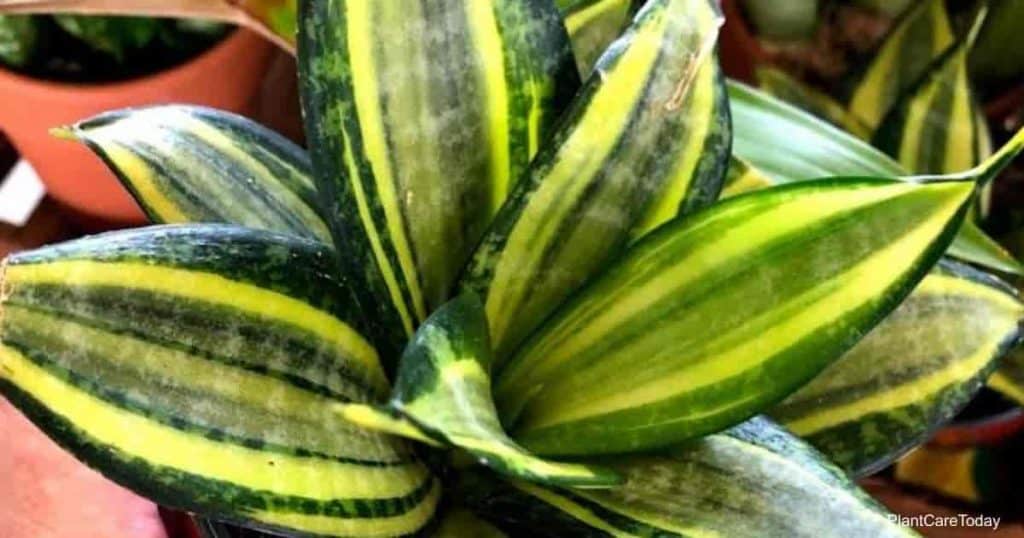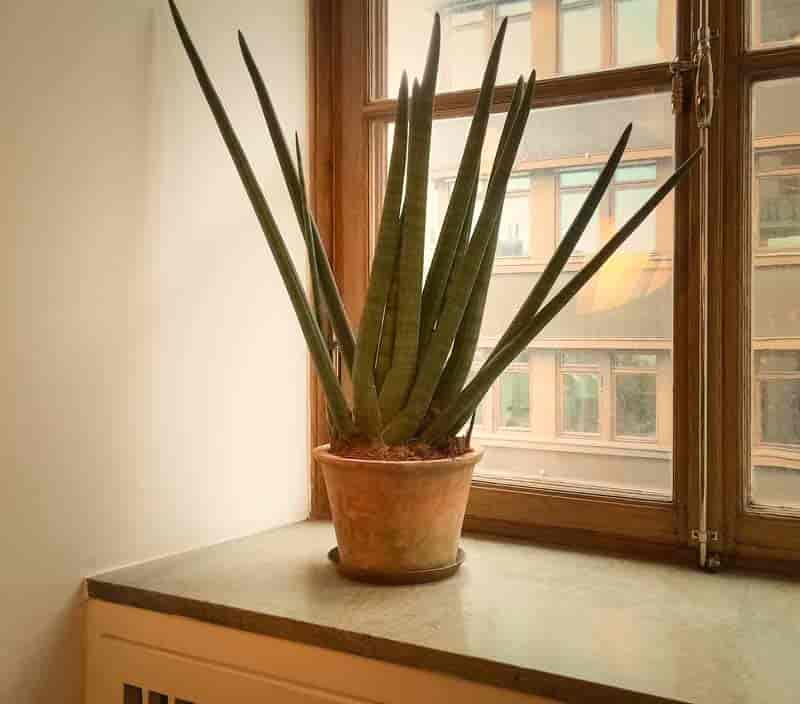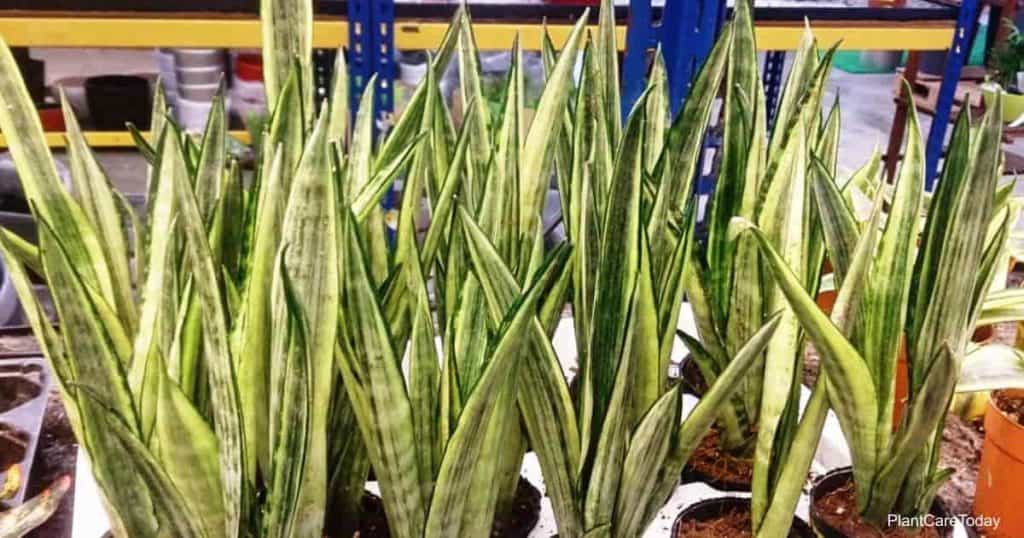When choosing plants for your garden or indoor collection, one important consideration is their final mature size. A plant might look great now but become far too large in three years for a particular area or container.
Many houseplants have gained popularity over the years, one of the unique looking being the plant known as the Snake Plant. This guide is designed to help you care for this amazing houseplant and find the perfect place based on its natural growth habits and size and the wide varieties available today. So how tall do snake plants get?

With that in mind, let’s get started!
Basics About Snake Plant You Need To Know
| Common Name | Snake plant, Viper’s bowstring hemp, St. George’s sword | |
| Botanical Name | Dracaena trifasciata (formerly Sansevieria trifasciata) | |
| Family | Asparagaceae | |
| Plant Type | Evergreen, perennial | |
| Mature Size | 6” inches to 8’ feet tall | |
| Sun Exposure | Shade to partial sun | |
| Soil Type | Sandy, well-drained | |
| Soil pH | Slightly acidic to slightly alkaline | |
| Bloom Time | Spring (rarely) | |
| Flower Color | White/cream | |
| Hardy Zones | 9–11 (USDA) | |
| Native Area | West Africa (tropical) | |
| Toxicity | Toxic to cats and dogs/causes dermatitis |
Getting To Know The Snake Plant Family
Dracaena trifasciata, commonly known as the snake plant, had a name change in 2017.
For decades, it has been classified as Sansevieria trifasciata. However, the common features and similarities to other Dracaena plant species were too many to overlook.
That is why scientists changed the classification and now include the Snake Plant as a plant related to different Dracaena plant varieties. More on Dracaena trifasciata vs Sansevieria.
This fascinating and beautiful unique plant features stiff, sword-like leaves that are thick and succulent-like.
The amazing thing about this plant is that its final mature size can range from 6″ inches to 8′ feet tall.
Snake plants can vary in color, with many shades of greens and gold, and yellows being features.
However, almost every Snake Plant leaf has a solid stripe of white or yellow that runs the entire margin of the leaf edge.
The Growth Habits Of The Snake Plant
These plants are easy to grow and, in many cases, are nearly indestructible.
They will thrive in very bright light or almost dark corners of the house. But, any sudden change in light level will shock the plant and take some time for it to adapt and acclimate to the new light environment.
Snake plants are relatively slow growers inside, which is perfect for many people. They can be sped along with brighter light and feeding of liquid plant fertilizer 1 to 2 times a year.
Planting and repotting is best done in the spring, and the plant will need to be protected from temperatures that fall below 50° degrees Fahrenheit and should never be allowed to freeze.
Types Of Snake Plants
The huge range of sizes that a Snake Plant can reach is due in part to the wide range of different varieties that have been discovered and bred over the years.
Some are designed to be very small and compact, while others maximize the mature size and height of the native Snake Plant varieties.
Here are some of the more common types you might find in your local garden center:
Dracaena Trifasciata ‘Hahnii’
This variety is often referred to as the Bird’s nest snake plant. It has a climbing growth habit and reaches only about 6″ inches of mature height.

Its leaf clusters form what resembles a bird’s nest hence the name.
Dracaena Angolensis
Dracaena angolensis (formerly Sansevieria cylindrica) is a variety different from many others in that it is known as a cylindrical snake plant.
Angolensi has round, stiff leaves that can be several feet in final mature length.

The leaves arch outward with a slight curve and from a central crown with a unique overall growth habit.
Dracaena Trifasciata ‘Laurentii’
Laurentii is a prized variant of the Snake Plant known as a variegated sansevieria.
It has creamy yellow leaf margins, much more white and yellows on the leaves, and a more compact growth habit.

Because there is less green for photosynthesis, this plant reproduces through shoots and underground rhizomes rather than leaf cuttings.
Dracaena Trifasciata ‘Twisted Sister’
This type of Snake Plant has typical long lance-shaped leaves, but with this variety, the twisted leaves are striped horizontally with yellow variegated edges.
This plant’s growth is mid-range, reaching about 15″ inches tall.
Dracaena Trifasciata ‘Bantel’s Sensation’
Bantel’s Sensation is a sub-variety growing about 3′ feet tall and has narrow leaves with white vertical stripes.

It is simple and easy to work in most gardens and is excellent as a filler plant due to its average size and spread.
Dracaena Pearsonii
This is one of the smaller varieties of Snake Plant and is fairly rare at times.
Sometimes called rhino grass, it grows about 12″ inches tall with succulent red-tinted leaves, making it a unique entry in the Snake Plant family tree.
Dracaena trifasciata is a wonderfully versatile and beautiful plant that can work well in many homes and gardens.
Finding the one with the best growth and mature height for your wants and needs comes down to knowing the available varieties and picking the one that is right for you!
